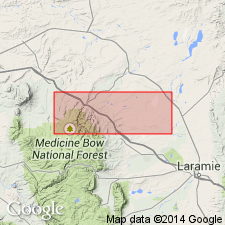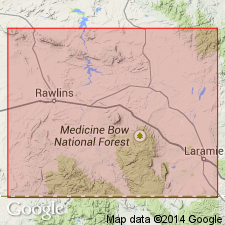
- Usage in publication:
-
- Medicine Bow formation*
- Modifications:
-
- Original reference
- Dominant lithology:
-
- Shale
- Sandstone
- Coal
- AAPG geologic province:
-
- Green River basin
Summary:
Pg. 228, 229, etc. Medicine Bow formation. Alternating beds of light-colored to gray carbonaceous shale, gray to brown sandstone showing cross-bedding, ripple marks, and other features of irregular deposition, and thin irregular beds of coal. Fresh- and brackish-water invertebrates, land plants, and vertebrate bones. Thickness 6,200+/- feet. Underlies fresh-water Ferris formation (Tertiary?), without proof of unconformity, and conformably overlies Lewis shale (marine). Age is Late Cretaceous. Is = "Lower Laramie" of Veatch.
Best exposed along both sides of North Platte River at mouth of the Medicine Bow [now submerged] in Hanna basin, Carbon Co., southern WY, [in secs. 14, 15, T. 24 N., R. 84 W., Seminoe Dam SE 7.5-min quadrangle].
[See also Dobbin and others, 1929, USGS Bull. 804, pl. 27, Geol. map and sections of Hanna and Carbon basins, WY, scale 1:62,500.]
Source: US geologic names lexicon (USGS Bull. 896, p. 1334).

- Usage in publication:
-
- Laramie (Carbon) group
- Bow formation
- Bow group
- Golden formation
- Golden group
- Modifications:
-
- Overview
- AAPG geologic province:
-
- Green River basin
Summary:
"Laramie (Carbon) group." A.C. Veatch, 1907 (Jour. Geol., v. 15, p. 547-549, and Amer. Jour. Sci., 4th series, v. 24, p. 18-22), in several places referred to "Laramie (Carbon) group" in Evanston section of southern Wyoming. He also expressed opinion that Laramie should be restricted to "Upper Laramie," and that a new name should be applied to "Lower Laramie," suggesting for the latter, "Bow formation or group" or "Golden formation or group."
Bow formation or group. Name suggested by A.C. Veatch (Jour. Geol., v. 15, p. 548, 1907, and Amer. Jour. Sci., 4th ser., v. 24, p. 18-22, 1907) as appropriate substitute for "Lower Laramie." From Medicine Bow River, WY.
Golden formation or group. Name suggested by A.C. Veatch (Jour. Geol., v. 15, p. 548, 1907) as appropriate substitute for the so-called "Lower Laramie" (=typical Laramie). From Golden, CO. [Later abandoned.]
In 1918 (USGS Prof. Paper 108, p. 229) C.F. Bowen introduced Medicine Bow formation to replace "Lower Laramie" of Hanna basin.
Source: US geologic names lexicon (USGS Bull. 896, Bow entry p. 243, Carbon entry p. 345, Golden entry p. 833).
- Usage in publication:
-
- Medicine Bow formation*
- Modifications:
-
- Revised
- Areal extent
- AAPG geologic province:
-
- Green River basin
Dorf, Erling, 1942, Upper Cretaceous floras of the Rocky Mountain region; Stratigraphy and paleontology of the Fox Hills and lower Medicine Bow formations of southern Wyoming and northwestern Colorado: Carnegie Institution of Washington Publication, Contributions to Paleontology, no. 508, 78 p., [Preprinted from Carnegie Inst. Wash. Pub., no. 508, 78 p., Dec. 12, 1938]
Summary:
Pg. 4-21. Medicine Bow formation. Redefined and stratigraphically restricted below to exclude approximately 400 feet of sediments which are termed Fox Hills. Base is considered to be lowest coal beds which separate underlying marine faunas from overlying fresh- and brackish-water faunas, and which also separates massive more persistent sandstones below from the thinner lenticular sandstones above. Thickness of restricted Medicine Bow in Wyoming 4,000 to 6,000 feet. Geographically extended into Craig area, Moffat County, northwestern Colorado, thickness 1,200+ feet. Age is Late Cretaceous.
Source: US geologic names lexicon (USGS Bull. 1200, p. 2445).
- Usage in publication:
-
- Medicine Bow formation*
- Modifications:
-
- Areal extent
- AAPG geologic province:
-
- Green River basin
Knight, S.H., 1951, The Late Cretaceous-Tertiary history of the northern portion of the Hanna basin, Carbon County, Wyoming: Wyoming Geological Association Field Conference Guidebook, no. 6, p. 45-53.
Summary:
Pg. 45-50. Medicine Bow formation. Thickness 3,200 to 4,000 feet in northern part of Hanna basin, southern Wyoming. Overlies Lewis formation; underlies conglomeratic sequence aggregating 13,500+ feet in thickness referred to as Ferris-Hanna formations. Upper Cretaceous (Lancian).
Source: US geologic names lexicon (USGS Bull. 1200, p. 2445).

- Usage in publication:
-
- Medicine Bow Formation*
- Modifications:
-
- Areal extent
- AAPG geologic province:
-
- Green River basin
Summary:
Medicine Bow Formation. Geographically restricted from Laramie and Carbon basins, southern Wyoming. Rocks mapped as Medicine Bow and Hanna Formations by Love and others (Wyoming State Geologic Map, 1955) in the northern part of Laramie basin and [southeastern part of] Carbon basin are reallocated to Foote Creek and Dutton Creek Formations (both new). In mapping the Laramie basin, authors found the Medicine Bow and Hanna beds cannot be traced from Hanna basin [type areas] into the Laramie or Carbon basin to establish a definite correlation.
Source: Publication.

- Usage in publication:
-
- Medicine Bow Formation*
- Modifications:
-
- Areal extent
- AAPG geologic province:
-
- Green River basin
Summary:
Pg. 5, 43-45. Medicine Bow Formation. Fluviatile sandstone, siltstone, and shale, with persistent beds of coal in lower part. Thickness 3,000 to 5,000 feet. Basal part = †Foote Creek Formation of Hyden and others (1965). (†Foote Creek abandoned herein.) Rests conformably on Fox Hills Formation. Conformably overlain by Ferris Formation; locally along east side of Hanna and Carbon basins is overlain by Hanna Formation with angular unconformity. Fossils. [Listed.] Age is Late Cretaceous.
Restricted to Hanna, Laramie, and Carbon basins, southern WY.
Source: Publication; Changes in stratigraphic nomenclature, 1970 (USGS Bull. 1354-A, p. A16-A17).
For more information, please contact Nancy Stamm, Geologic Names Committee Secretary.
Asterisk (*) indicates published by U.S. Geological Survey authors.
"No current usage" (†) implies that a name has been abandoned or has fallen into disuse. Former usage and, if known, replacement name given in parentheses ( ).
Slash (/) indicates name conflicts with nomenclatural guidelines (CSN, 1933; ACSN, 1961, 1970; NACSN, 1983, 2005, 2021). May be explained within brackets ([ ]).

